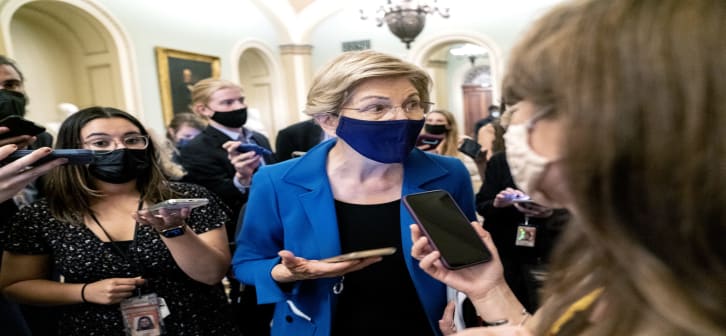Senators Call for Streamlined Student Debt Relief, Loan Forgiveness
Writer
Writer

- Seven senators sent a letter to Education Secretary Miguel Cardona urging changes to the income-driven repayment process.
- It also requested that debt for students who attended schools that closed while they were enrolled be discharged.
- The letter was sent as the department is negotiating new regulations for higher education.
While Congress continues to be focused on President Joe Biden's Build Back Better Act, seven U.S. senators are working to keep the student debt crisis at the top of the administration's priority list.
In a letter to Department of Education Secretary Miguel Cardona, seven Democratic senators pushed for regulatory changes for higher education and student loans. They urged Cardona to consider a proposal that would streamline the income-driven repayment process for those with outstanding student loans and another proposal that would discharge debt for students who attended schools that closed while they were enrolled.
The senators who signed the letter were:
- Richard Durbin of Illinois
- Patty Murray of Washington
- Sherrod Brown of Ohio
- Elizabeth Warren of Massachusetts
- Tammy Baldwin of Wisconsin
- Mazie Hirono of Hawaii
- Edward Markey of Massachusetts
The letter arrives on Cardona's desk while the Department of Education is undergoing a negotiated rulemaking process for higher education, also referred to as a "reg-neg." This process involves the department meeting with interested parties to create new regulatory rules for the higher ed system.
The letter clarified that negotiations related to borrower assistance thus far should be applauded, but stated that additional changes are needed.
"The Department's initial proposals to simplify and expand student loan discharge options and repayment plans were a positive and much-needed step forward in helping borrowers get the assistance they need and deserve," the letter stated.
Proposed Changes to Repayment Plans
First, the senators pitched a proposal to streamline income-driven repayment (IDR) of student loans.
The problem with the current IDR system, the senators wrote, is that there is no singular plan. Because of this, it's often difficult for those in debt to understand how to enroll in IDR and which plan they should choose.
The senators instead proposed streamlining it into a singular IDR plan maintained by the Department of Education.
This proposed plan would cap payments at no more than 10% of a borrower's monthly income. The repayment period should be no longer than 20 years, the letter states, and it should protect an amount equal to 250% of the poverty guideline so that borrowers can prioritize basic living expenses.
The poverty guideline is issued by the Department of Health and Human Services to determine what income threshold households would need to meet to qualify for financial aid from certain federal programs. The poverty line for a household of four, for example, is $26,500.
All new enrollments into IDR plans would sunset into this singular plan, according to the proposal.
More Lenient Rules Around Student Loan Discharge
Current guidelines state that students can have outstanding student loan debt discharged if the school they attended closed while they were enrolled, or if it closed permanently within six months after they withdrew. It's a mechanism that helps protect former students from predatory institutions that folded, potentially swindling them out of thousands of dollars.
However, current rules don't allow a student's loans to be discharged if they were able to transfer credits from their closed school to another school.
According to a report from the U.S. Government Accountability Office in late September, 44% of borrowers transfer to another school after a closure, making them ineligible for forgiveness. Approximately 1,100 colleges have closed since 2010, impacting about 246,000 borrowers.
“When institutions of higher education close their doors permanently ... all students who attended that institution are harmed”
The senators who signed the letter want to change the transfer rules. According to their letter, they propose that the Department of Education should discharge all student debt if it accrued from a school that closed within the six-month timeline, regardless of whether a student is able to transfer credits.
"When institutions of higher education close their doors permanently, whether abruptly or
over a more gradual period, all students who attended that institution are harmed — even if the
student is later able to navigate the gauntlet of the transfer process," the senators wrote.
They went on to write that employers oftentimes doubt the credibility of an institution that closed while a prospective hire was a student, so it makes these ex-students less employable. By discharging debt, it would help level the playing field and allow them to pursue a degree at a new school.
Feature Image: Bloomberg / Contributor / Bloomberg / Getty Images
Latest News
Related Stories
Featured Stories
Latest Analysis
College Accreditation Is Changing. Here’s What Students Need To Know.

11 Red States Are Suing to Block Biden's SAVE Loan Repayment Plan. Here's What Borrowers Need to Know.

Here's Where the 2024 Presidential Candidates Stand on Higher Education

College Admissions, Student Diversity, and Campus Culture 50 Years Ago











